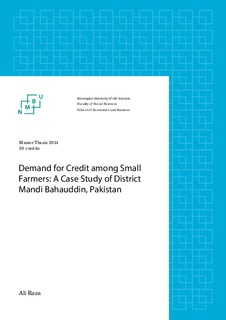| dc.description.abstract | In this research, I investigated the determinants of demand for credit and consumption of credits among small farmers of district Mandi Bahauddin, Pakistan.
For this purpose, I interviewed 123 households of six villages of this district. Both qualitative and quantitative techniques were employed to examine factors that affect demand for credits. Seven hypotheses were devised and tested and probit and OLS models were used to analyze the effects of education, household size and income on demand for credit. For sake of clear understanding, income variable was further decomposed into three types of income i.e. livestock income, agricultural production income and other sources of income.
I found that informal borrowing (from friends and relatives), higher interest rate and high transaction costs crowded out formal lending. However, consumption smoothing was not a major reason for demand for formal loans. A positive correlation was found between education and demand for credit. Household size and all types of incomes did not significantly correlate with demand for credit. Moreover, being residents of villages Lakhnewala and Badshahpur showed higher probability of demand for credit than being resident of Kangsahali, whereas being residents of Shahidanwali, Wara Alam Shah and Chak Abdullah did not affect demand for credit. | nb_NO |
